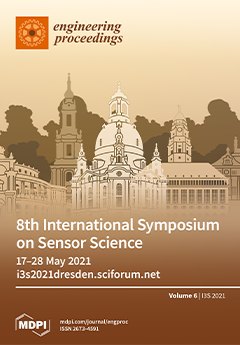The fast and selective determination of hydrogen peroxide (H
2O
2) is of importance not only because of strong interest in this widely applied analyte, but also because of the development of enzymatic biosensors for glucose or other metabolites where the
[...] Read more.
The fast and selective determination of hydrogen peroxide (H
2O
2) is of importance not only because of strong interest in this widely applied analyte, but also because of the development of enzymatic biosensors for glucose or other metabolites where the sensor for H
2O
2 can be used as the transducer. Here, we report on an electrocatalytical amperometric sensor for the detection of H
2O
2. It is a sensor that consists of a gold electrode covered by a self-assembled monolayer (SAM) with immobilized p-benzoquinone. To provide highly stable immobilization of p-benzoquinone at the distance of effective electron tunneling, a new anchor compound—1,3-dimercaptopropan-2-ol—was synthesized and used for preparation of the SAM. Due to two thiol groups binding gold surface, this compound provides high stability of the SAM. The surface concentration of p-benzoquinone obtained from cyclic voltammetry is 2.5 ± 0.2 × 10
−10 mol·cm
−2. Cyclic voltammetry and chronoamperometry experiments proved that the immobilized benzoquinone exhibited high electrocatalytic activity towards the decomposition of H
2O
2. Depending on the used potential range, different sensing modes can be realized. For example, one can measure electrochemical response due to the oxidation of H
2O
2 at anodic potentials, or due to the reduction of oxygen formed during oxidative decomposition of H
2O
2. Also, amperometric response at fixed potential of +0.4 V vs. Ag/AgCl corresponding to the oxidation of benzoquinone to hydroquinone was studied. The sensor exhibited a linear response over a concentration range of 0.1–2 mM with a low detection limit of 4.24 µM. The reproducibility of three different electrodes prepared was examined at the H
2O
2 concentration range from 0.1 till 3 mM, which resulted in a relative standard deviation below 4.2%.
Full article




